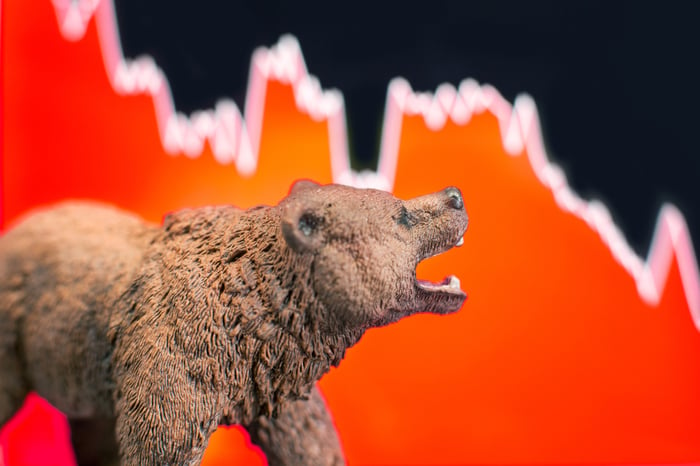As much as we enjoy Wall Street's ups, the downs are a normal part of the investing cycle. Last year, all three major U.S. stock indexes fell into a bear market, with the growth-dependent Nasdaq Composite (^IXIC -1.79%) really taking it on the chin. The index most responsible for pulling the broader market to new highs in 2021 shed 33% of its value last year.
But for investors with time on their side, there's good news: Eventually, every sizable decline in the major indexes -- including the Nasdaq Composite -- has eventually been cleared away by a bull market. It effectively means that every bear market provides an opportunity to scoop up innovative businesses at a discount.

Image source: Getty Images.
Since growth stocks have been hit the hardest by volatility and uncertainty since the beginning of 2022, they're an excellent place to consider putting your money to work. What follows are five marvelous growth stocks you'll regret not buying on the Nasdaq bear market dip.
Amazon
The first magnificent growth stock that's begging to be bought during the Nasdaq bear market swoon is e-commerce behemoth Amazon (AMZN -1.35%). Although retail sales are liable to remain weak, with numerous recession-probability indicators suggesting tough times ahead for the U.S. economy, Amazon's most important operating segments are chugging right along.
Despite accounting for an estimated 39.5% of U.S. online retail sales in 2022, according to eMarketer, Amazon's online marketplace generates very low margins. The key to Amazon's success is that subscription services, advertising services, and cloud infrastructure services are continuing to grow by a double-digit percentage (on a constant-currency basis). These are considerably higher-margin operating segments, relative to online retail sales.
For instance, Amazon has signed up more than 200 million people globally to a Prime membership. It's continually adding new members to Prime and has the pricing power to increase monthly/annual dues for Prime members, if necessary.
There's also Amazon Web Services (AWS), which brought in 32% of all cloud infrastructure service spending in the fourth quarter, according to estimates from tech-analysis firm Canalys. AWS sports an annual sales run-rate of more than $85 billion, and it's the operating segment responsible for the lion's share of Amazon's operating income.
Even if Amazon's retail sales contract, the company's operating cash flow can meaningfully grow thanks to its high-margin ancillary segments.
Fiverr International
The second stellar growth stock you'll be kicking yourself for not buying during the Nasdaq bear market drop is online-services marketplace Fiverr International (FVRR 0.25%). Even with the U.S. unemployment rate likely to rise in the quarters to come, Fiverr offers well-defined, sustainable competitive advantages.
On a macro basis, Fiverr is going to benefit from the COVID-19 pandemic permanently changing the composition of the labor force. Though some workers are back in the office, more people are working remotely than ever before. This fits in perfectly with Fiverr's freelancer marketplace.
But there's more to this story than simply "more people are working remotely." Fiverr's freelancer platform is also differentiated from the vast majority of online-service marketplaces. Whereas most of its competition lists tasks and jobs on an hourly basis, Fiverr freelancers price their jobs as a packaged deal. This means buyers can expect unparalleled price transparency, which is a big reason why the number of active buyers and spend per buyer have continued to climb.
What's more, Fiverr's take-rate is unrivaled among online-service marketplaces. This "take-rate" describes how much of each deal negotiated on its platform that Fiverr gets to keep. It rose during the fourth quarter to 30.2%. This is practically double its core competitor, and it should allow Fiverr's profit growth to outpace its sales growth for the foreseeable future.

Image source: Getty Images.
JD.com
A third marvelous growth stock you'll regret not buying as the Nasdaq plunges is China-based e-commerce company JD.com (JD 0.12%). Although fears of a price war between JD and key competitors like Alibaba recently dented JD's share price, there are a number of sustained catalysts working in JD's favor.
Like Fiverr, there's a macro tailwind benefiting JD.com. After three years of stringent COVID-19 mitigation measures, China has reopened its economy. While the path to normalcy could be a bit bumpy for a couple of quarters as Chinese citizens build some level of immunity to COVID-19, a reopened economy is, ultimately, a positive for JD.com and its rapidly growing online marketplace.
As I recently opined, what makes JD such an intriguing investment is its operating model. Whereas Alibaba is primarily driven by third-party marketplaces, JD.com is a direct-to-consumer retailer. This means it oversees its inventory and logistics (like Amazon), which also allows JD greater control of its expenses and operating margin. Over time, this can allow JD to outpace Alibaba in the growth department.
JD.com has sales channels outside traditional online retail as well. This includes the company's Logistics and Health operating segments, which have the potential to grow even faster than its online marketplace.
Green Thumb Industries
The fourth phenomenal growth stock you'll regret not buying during the Nasdaq bear market decline is U.S. marijuana stock Green Thumb Industries (GTBIF -1.96%). Although pot stocks have been a buzzkill, with the U.S. federal government failing to pass cannabis banking reforms, Green Thumb has stood out from its peers in a variety of positive ways.
The real eye-popper here is that Green Thumb, which had 77 operating dispensaries and a presence in 15 states, as of the beginning of December, has delivered nine consecutive quarters of generally accepted accounting principles (GAAP) profit (note, Green Thumb reports its fourth-quarter results on Feb. 28, and this write-up was completed prior to this report). Most multi-state operators (MSO) haven't even achieved their first quarter of GAAP profits.
Green Thumb's not-so-hidden secret is its revenue mix. While dried cannabis flower is the most-popular pot product, well over half of Green Thumb's sales come from derivative cannabis products, such as vapes, beverages, and edibles, among other things. Derivative marijuana products sport higher price points and substantially higher margins than dried cannabis flower.
Green Thumb Industries is also benefiting from its prudent expansion strategy. Though it does have a presence in a number of high-dollar markets (e.g., California, Colorado, and Florida), it's been edging its way into limited-license states, such as Pennsylvania, Virginia, Massachusetts, and Ohio. Markets where dispensary license issuance is purposely limited ensures that Green Thumb has a fair shot to build up brand awareness and gain a loyal following.
PayPal Holdings
A fifth marvelous growth stock you'll regret not buying during the Nasdaq bear market dip is fintech giant PayPal Holdings (PYPL -1.67%). Though high inflation could temper how much the lowest decile of earners spends over the short term, PayPal's important performance metrics continue to point upward.
In spite of U.S. gross domestic product declining during the first half of 2022, PayPal delivered a 13% year-over-year increase in total payment volume (TPV) on its digital networks (Venmo and PayPal), sans currency movements. In an expansionary economy, TPV has pretty consistently grown by 20% or more per year. Maintaining double-digit TPV growth in such a challenging economic environment demonstrates how impressive the growth runway is for digital payments.
The important thing for investors to understand about PayPal is that it's a usage-driven model. When 2020 came to a close, PayPal's active customers averaged 40.1 transactions over the trailing-12-month (TTM) period. As of the end of 2022, active customers completed an average of 51.4 transactions over the TTM. If active customers continue to be more engaged, it's only logical to expect that PayPal's gross profit will climb.
Something else to consider is that PayPal's capital-return program and cost-cutting efforts will make an already cheap stock look that much more attractive. PayPal is aiming to shave at least $1.3 billion off its annual operating expenses in 2023, and it announced a $15 billion share repurchase program last summer. Based on Wall Street's forward-year earnings forecast, PayPal is cheaper than it's ever been as a publicly traded company.




